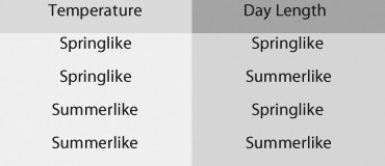Multiple Choice
Figure 1.1
The following experiment is used for the corresponding question(s) .
A researcher discovered a species of moth that lays its eggs on oak trees.Eggs are laid at two distinct times of the year: early in spring when the oak trees are flowering and in midsummer when flowering is past.Caterpillars from eggs that hatch in spring feed on oak flowers and look like oak flowers.But caterpillars that hatch in summer feed on oak leaves and look like oak twigs.
How does the same population of moths produce such different-looking caterpillars on the same trees? To answer this question,the biologist caught many female moths from the same population and collected their eggs.He put at least one egg from each female into eight identical cups.The eggs hatched,and at least two larvae from each female were maintained in one of the four temperature and light conditions listed below.

Figure 1.1
In each of the four environments,one of the caterpillars was fed oak flowers,the other oak leaves.Thus,there were a total of eight treatment groups (4 environments × 2 diets) .
-Refer to Figure 1.1.Recall that eggs from the same female were exposed to each of the eight treatments used.This aspect of the experimental design tested which of the following hypotheses?
A) The longer day lengths of summer trigger the development of twig-like caterpillars.
B) Differences in air pressure,due to elevation,trigger the development of different types of caterpillars.
C) Differences in diet trigger the development of different types of caterpillars.
D) The differences are genetic-a female will produce all flowerlike caterpillars or all twig-like caterpillars.
Correct Answer:

Verified
Correct Answer:
Verified
Q6: The best experimental design _.<br>A)includes a large
Q7: Which of the following statements about cells
Q8: Which of the following observations led to
Q9: You find yourself standing next to a
Q10: Recall the caterpillar experiment,where caterpillars born in
Q12: Current evolutionary data groups land plants with
Q13: If you find a mouse in your
Q14: Agrobacterium is a type of bacteria that
Q15: Lance Armstrong just finished third (by about
Q16: What do nodes on a phylogenetic tree